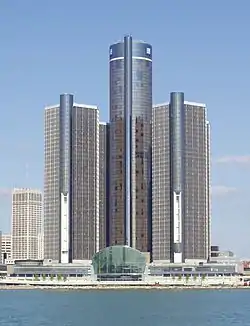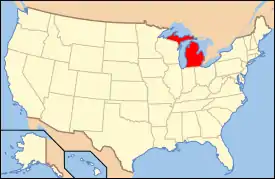Lee Plaza (Detroit)
The Lee Plaza (also known as the Lee Plaza Hotel or Lee Plaza Apartments) is a vacant 15-story high-rise apartment building located at 2240 West Grand Boulevard, about one mile west of New Center along West Grand Boulevard, an area in Detroit, Michigan. It is a registered historic site by the state of Michigan and was added to the United States National Register of Historic Places on November 5, 1981. Designed by Charles Noble and constructed in 1929, it rises to 15 floors and is an excellent example of Art Deco architecture of the 1920s.[2]
Lee Plaza Hotel | |
 | |
 | |
| Location | 2240 W. Grand Blvd. Detroit, Michigan |
|---|---|
| Coordinates | 42°21′34″N 83°6′6″W |
| Area | less than one acre |
| Built | 1928 |
| Architect | Charles Noble |
| Architectural style | Art Deco |
| NRHP reference No. | 81000319[1] |
| Added to NRHP | November 5, 1981 |
History
The Lee Plaza Hotel was built in 1928 for Ralph T. Lee, a Detroit developer. Noted residential architect Charles Noble designed the building.[3] It was constructed to be an upscale apartment with hotel services. Decorated with sculpture and tile outside, the structure rivaled the Book-Cadillac and Statler Hotels for architectural notice in Detroit during the 1920s. The building opened in 1929, but Lee quickly sold it to the Detroit Investment Co.[4] Like many companies, the Detroit Investment Co. had financial issues at the beginning of the Great Depression, and the Lee Plaza went through a series of owners, some of whom Ralph T. Lee had an interest in. By 1935 both Ralph Lee and the Lee Plaza were bankrupt.[4]
The ownership of the building was tied up in court until 1943.[4] However, in that time luxury apartment living had fallen out of favor, residents left, and the hotel started renting rooms to transient guests. In 1968, the city of Detroit turned the building into a senior citizens' complex.[3] However, in the 1980s, the Lee began losing residents, and the building was finally closed in 1997.[4]
Since that time, the Lee Plaza has been stripped of many of its architectural elements.[4] The city has looked for a redeveloper, and in 2015, developer Craig Sasser, announced a $200 million redevelopment of Lee Plaza and the surrounding area.[5][6] However, in October 2016, Harold Ince, interim executive director of the Detroit Housing Commission announced that the planned redevelopment appears dead after Sasser failed to purchase the property.[7] In December 2017, the city issued an RFP (requests for proposal) for the 17-story Lee Plaza Tower on West Grand Boulevard at Lawton Street. The city received three proposals to redevelop the historic tower in March 2018 but ultimately decided in July that none were viable reuses of the 1929 building. New proposals for the building, which has undergone a $400,000, two-phase stabilization project, are now being accepted on a rolling basis.[8]
In February 2019, the city of Detroit announced plans to sell Lee Plaza to a joint venture of the Roxbury Group and Ethos Development Partners for $350,000, that will redevelop the building into 180 residential units and retail. Construction is expected to start as early as 2021, cost at least $50 million, with half of the apartments affordable.[9]
Description
The Lee Plaza Hotel is a 15-story, "I" plan, steel and reinforced concrete structure, faced with orange glazed brick, with a steeply pitched roof originally covered in red tile (later replaced with copper, which has been since stripped).[4] The first story of the building is forms a terra cotta clad base with molded Palladian windows, from which prominent brick piers rise to the roof, forming strong vertical lines. Decorative details are inset in the form of terra cotta belt courses, spandrel plaques, corbelled friezes and window surrounds.[3]
The interior contains 220 one to four room apartments. The first floor has a main lobby with a coffered ceiling, east and west lounges, two wood-panelled dining rooms, and a ballroom. The main hallway was dubbed "Peacock Alley," a barrel-vaulted space with coffered ceiling covered in a rich color scheme of blues, golds and greens.[3] The basement originally contained a beauty parlor, a game room, a children's playroom, and a meat market and grocer.[4]
Gallery
 The vacant structure has no windows
The vacant structure has no windows The street level, bricked up and fenced
The street level, bricked up and fenced The roof is heavily damaged
The roof is heavily damaged Rooftop of the Lee Plaza in 2016, an abandoned high rise building in Detroit, MI
Rooftop of the Lee Plaza in 2016, an abandoned high rise building in Detroit, MI
See also
- National Register of Historic Places in Detroit, Michigan
References
- "National Register Information System". National Register of Historic Places. National Park Service. July 9, 2010.
- Michigan Historical Center. Historic Sites Online. Archived 2009-03-13 at the Wayback Machine "Lee Plaza" Archived 2010-04-06 at the Wayback Machine
- Les Vollmert (June 16, 1981), National Register of Historic Places Inventory-Nomination Form: Lee Plaza Hotel
- Dan Austin, Lee Plaza, historicdetroit.org
- "Buyer seeks $200M redevelopment of Lee Plaza".
- "Developer wants luxury apartments back in Lee Plaza".
- "$200 million Lee Plaza redevelopment deal appears dead".
- "Major development/redevelopment requests for proposals Detroit has issued under Mayor Mike Duggan".
- "Detroit to sell Lee Plaza for 180-unit redevelopment".
Further reading
- Hill, Eric J.; John Gallagher (2002). AIA Detroit: The American Institute of Architects Guide to Detroit Architecture. Wayne State University Press. ISBN 0-8143-3120-3.
- Meyer, Katherine Mattingly and Martin C.P. McElroy with Introduction by W. Hawkins Ferry, Hon A.I.A. (1980). Detroit Architecture A.I.A. Guide Revised Edition. Wayne State University Press. ISBN 0-8143-1651-4.CS1 maint: multiple names: authors list (link)
- Sharoff, Robert (2005). American City: Detroit Architecture. Wayne State University Press. ISBN 0-8143-3270-6.
External links
| Wikimedia Commons has media related to Lee Plaza. |
- Kohrman, David. Forgotten Detroit "Lee Plaza Hotel" 2004. (Accessed 19 April 2008)
- Lee Plaza Apartments at Emporis.com
- Photo gallery at Detroiturbex.com


